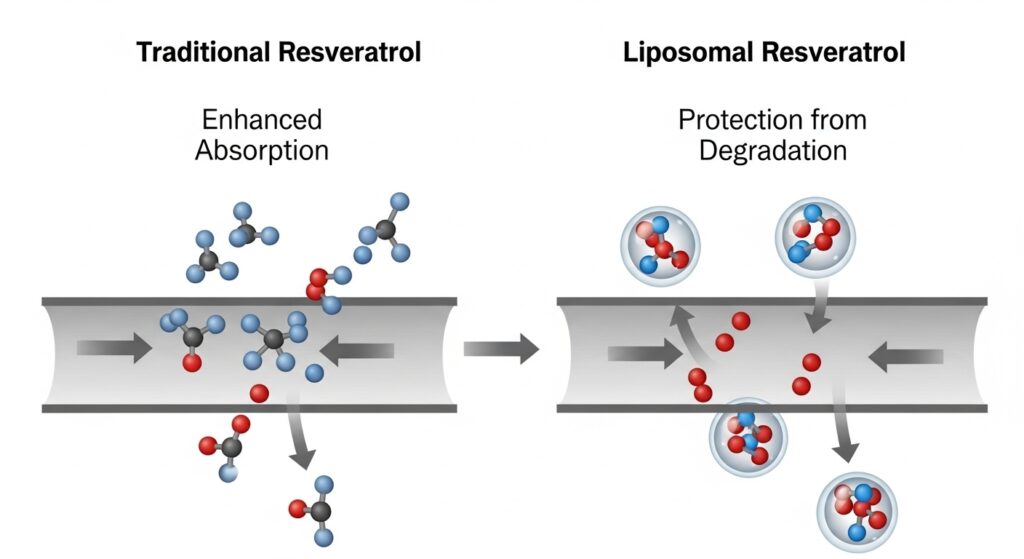Introduction: Why Resveratrol’s Promise Often Falls Short
Resveratrol, a natural polyphenol found in red grapes and Japanese knotweed, has captured global attention for its powerful antioxidant, anti-inflammatory, and longevity-enhancing properties. Research links it to cardiovascular protection, metabolic regulation, and cellular rejuvenation. However, when taken orally, the vast majority of resveratrol fails to reach the bloodstream in active form—making its benefits difficult to realize in practical applications.

Gastrointestinal Barriers to Resveratrol Absorption
1. Poor Solubility and Instability
Resveratrol has low water solubility and is highly sensitive to pH, light, and oxygen. In the acidic environment of the stomach, it begins to degrade, and even before reaching systemic circulation, its molecular structure is often compromised.
1. Extensive First-Pass Metabolism
Once absorbed, resveratrol is rapidly metabolized by enzymes in the liver and intestines through glucuronidation and sulfation. Studies suggest that less than 1% of orally ingested resveratrol reaches systemic circulation in its bioactive form [1].
Liposomal Delivery: A Game-Changer for Resveratrol
1. Encapsulation for Stability
Liposomal technology involves encapsulating resveratrol within phospholipid bilayers, which protect it from environmental degradation. This structure mimics the body’s own cell membranes and shields resveratrol from stomach acid, oxidative stress, and enzymatic breakdown.
2. Enhanced Bioavailability
Liposomal resveratrol shows significantly higher absorption rates. The vesicle structure facilitates cellular uptake either via fusion with enterocyte membranes or through endocytosis. This bypasses much of the liver’s first-pass effect, allowing more intact resveratrol to enter the bloodstream.
3. Prolonged Plasma Retention
Liposomal delivery also extends the residence time of resveratrol in the blood. This steady release can sustain physiological benefits longer than standard forms.

Research Supporting Liposomal Resveratrol
- A pharmacokinetic study published in Molecules (2019) demonstrated a 3–5x higher plasma concentration of liposomal resveratrol compared to standard formulations [2].
- In vitro models show that liposomal encapsulation protects over 70% of resveratrol in simulated gastric fluid for more than 2 hours.
- Animal trials observed better tissue distribution and antioxidant activity with liposomal delivery compared to free resveratrol.
Implications for B2B Buyers and Supplement Developers
1. High-Efficacy Positioning
Brands looking to offer proven longevity or anti-aging supplements can leverage liposomal resveratrol as a premium, high-performance solution with scientific backing.
2. Competitive Differentiation
For raw ingredient traders and manufacturers, liposomal resveratrol provides:
- Justification for premium pricing
- Reduced degradation during formulation
- Marketing narratives focused on clinical efficacy
📎 Related Reading:
- Why Reduced Glutathione Needs Liposomal Delivery: The Key to Stability and Efficiency
- Do Liposomes Really Improve Absorption? Six Ingredient Comparisons
Conclusion: Liposomal Resveratrol Unlocks the Full Potential
Traditional resveratrol supplements face significant hurdles in delivering consistent and measurable benefits. Liposomal technology overcomes these biological limitations, allowing higher plasma levels, greater stability, and improved bioavailability. For manufacturers and consumers alike, liposomal resveratrol represents a future-forward approach to maximizing the impact of this potent molecule.
References
[1] Walle, T. (2011). “Bioavailability of resveratrol.” Annals of the New York Academy of Sciences, 1215(1), 9-15.
[2] Neves, A. R. et al. (2019). “Liposomal formulations for resveratrol delivery: A promising strategy for its bioavailability improvement.” Molecules, 24(1), 1-18.